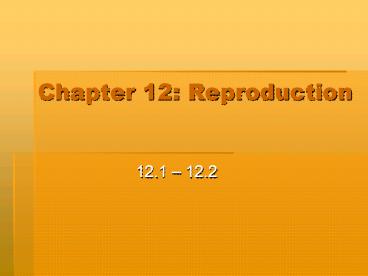Chapter 12: Reproduction - PowerPoint PPT Presentation
1 / 18
Title:
Chapter 12: Reproduction
Description:
Chapter 12: Reproduction 12.1 12.2 12.1 Asexual Reproduction Process of reproduction by a single parent produces GENETICALLY IDENTICAL OFFSPRING Clones ... – PowerPoint PPT presentation
Number of Views:365
Avg rating:3.0/5.0
Title: Chapter 12: Reproduction
1
Chapter 12 Reproduction
- 12.1 12.2
2
12.1 Asexual Reproduction
- Process of reproduction by a single parent ?
produces GENETICALLY IDENTICAL OFFSPRING - Clones the offspring of asexual reproduction
(genetically identical)
3
12.1 Asexual Reproduction
- Examples
- Binary fission occurs in Prokaryotes produces
2 identical cells (cell divides into 2 after its
DNA has been - copied)
4
12.1 Asexual Reproduction
- Mitotic division Happens in Unicellular
eukaryotes, such as a Paramecium, which creates 2
new identical organisms by dividing through
mitosis
5
12.1 Asexual Reproduction
- Budding In Hydra a bud breaks away from
parent to live independently
6
12.1 Asexual Reproduction
- Fragmentation In Planeria (flat worms), an
organism breaks into pieces and each fragment
turns into a new organism
7
12.1 Asexual Reproduction
- Vegetative Reproduction (Propagation) In certain
plants, like grasses, runners are used to help
them spread quickly - This can be done artificially as well.
8
12.1 Asexual Reproduction
- Artificial Vegetative Reproduction
- Horticulturalists farmers will use cuttings
from a parent plant to create identical plants
9
12.1 Asexual Reproduction
- Artificial Vegetative Reproduction
- In grafting, 2 plants are used to develop a new
plant that has the desired characteristics
10
Asexual Reproduction
- Advantages
- Happens quickly
- Requires less energy
- No need to find a mate
- Offspring usually well-adapted because parents
are able to reproduce
- Disadvantages
- NO genetic variation (susceptible to diseases,
environmental changes, predators) - Only 1 parent for offspring (sometimes parent
disappears completely binary fission)
11
Chromosomes
- What are chromosomes?
- What do living things need them for?
12
12.2 Chromosome Number
- Every species has a characteristic number of
chromosomes - Examples
- Prokaryotes 1 major chromosome
- Humans 46 chromosomes
- Turkeys 82 chromosomes
13
12.2 Chromosome Number
- In sexually reproducing organisms
- The typical chromosome number occurs in pairs
- Ex humans have 46 chromosomes 23 pairs of
chromosomes - Source of pairs each parent provides one
chromosome of the pair
14
12.2 Chromosome Number
15
12.2 Chromosome Number
- Diploid (2n) a cell with the double set of
chromosomes - Diploid human cell 46 chromosomes
- Haploid (n) a cell with one set of chromosomes
- Haploid human cell 23 chromosomes
- What kind of cells would only have ½ the number
of chromosomes?
16
12.2 Chromosome Number
- In Organisms that reproduce sexually
- Sex cells (gametes) must be haploid
- Why?
- Two gametes fuse together during fertilization,
each must be haploid so that the resulting zygote
is diploid
17
12.2 Chromosome Number
- Gametes Reproduction
- Males sperm
- Females ovum (egg)
- Fertilization sperm egg (haploid) nuclei
fuse, resulting in a zygote (diploid) - Zygote the diploid cell that results from
fertilization
18
12.2 Chromosome Number
- Meiosis process that produces haploid gametes
(sperm eggs) - It can also produce spores haploid cells that
can produce haploid organisms































